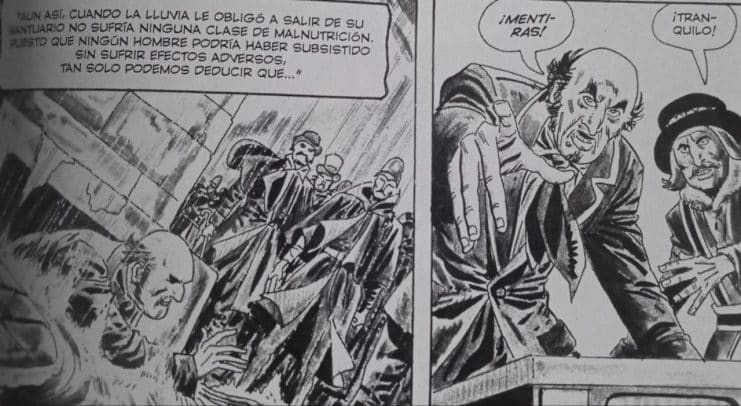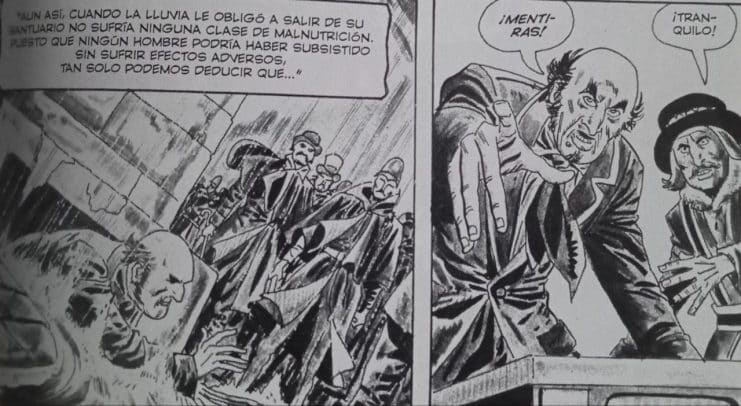
Creepy, the most legendary horror series of the ninth art, returns from the hands of Planeta Cómic in two new ones full of incredible stories
There are comics that never die, that resist aging even if they are half a century old. Creeping it’s one of them. That mix of magazines pulpa short horror story and a creative laboratory, it turned each episode into a feast of scares and surprises, where you might stumble upon a classic gothic story or a satirical science fiction fable. Now Comic planet publishes two very different volumes that collect materials separated by almost seventy issues (and a few years, almost a decade) apart. In the first the golden age Warrenwhen the best writers and artists competed for pages. The second, however, reflects the shocks of the final phase, when the magazine tried to stay afloat through ups and downs but continued to propose little jewels that are worth saving. The beauty of reading them in succession is that they work almost like a mirror: on the one hand we have the splendor of seventies horror in black and white and on the other the desire to continue to scare in the midst of the eighties, with a more irregular air but also with unexpected flashes.


Disturbing 7
These numbers correspond to the era in which Warren still enjoyed a unique splendor. The covers, fortunately not changed much over time, are already a spectacle in themselves. We had monsters with hypnotic gazes, women in danger and a nightmarish climate that already predisposes the reader to enter the game. But what is really engaging are the internal stories, where each issue offers a carousel of ideas that seem to have come out of a meeting of screenwriters who had decided to imagine the strangest story they could think of and give it a macabre twist on the last page.
Here Creepy still maintains that intermediate spirit pulp and half sly, where the stories not only try to scare, but also to raise a crooked smile. It is evident in space science fiction stories such as one is too manywhich plays with the classic morality of excess taken to the extreme. What begins as a more or less controlled situation ends up degenerating into the grotesque, with that sense of black humor that was a trademark of the house and which made this series occupy a special place in the black hearts of its readers.
We also have little gems like X-Extrawhere the final twist raises eyebrows with a knowing smile. It is one of those stories that seem almost anecdotal, but which in just a few pages manage to hook and deliver a final blow that the most innocent reader will be able to keep in his memory for years like that moment in which his life changed. Something similar happens with difficult customerswhich perfectly exploits the idea that true terror can be found in the most everyday interactions. All it takes is a shop, a strange customer, a hint of gangsterism and suddenly the situation takes a brilliant turn towards the macabre.
And then there is A way to overcome boredomwhich encapsulates very well what made these comics great: taking a simple emotion, in this case boredom, and turning it into an excuse for excess, for the sinister, for the absurd and for the occasional appearance of the demon. And let’s not forget those pages dedicated to the Creepy fan club, a true jewel saved by time that will probably make fans of this type of publications shed tears of joy, with micro-stories written in prose, with all the flavor of Creepy, truly enjoyable.
In general, what you breathe in this volume is classic Creepy: very expressive drawings, scripts that don’t shy away from the macabre and the feeling that each comic is a sort of joke told by the light of a candle on a stormy night.


Disturbing 21
In this volume we have a total change of tone. Here we are no longer in the initial golden age, but in a phase in which the magazine dared to try different, and sometimes very strange, things. The terror of the Eighties (late Seventies actually, even if the era can be identified by those sharks we see on the cover, since the film Steven Spielberg because of these sharks it had scared many people from swimming on the beach) had a different color. It was darker, dirtier and with one foot in experimentation, and this shows in almost every story that appears in this volume.
The first thing that catches your attention is the graphic contrast, as many artists here work with a more aggressive line, with compositions that try to make people uncomfortable. There are stories that feel like they come from a bad psychedelic trip and others that feel straight out like political satire masquerading as horror stories. The magazine no longer just wanted to scare, it now tried to shake the reader.
Some stories stand out for the level of explicit violence, others for the surreal nature of their proposals. This volume shows a Creepy experimenting with what could and could not be done in genre comics in those years. If before we played with almost naive plot twists, now the conclusions are more brutal, more desperate. The cruelty is greater and in some cases the dark humor disappears almost completely, replaced by a sort of nihilism that leaves a very bad feeling. But this is precisely part of its charm. There’s a kind of twisted beauty in seeing how the publication was adapting to new times, reflecting a social and cultural environment in which terror was no longer a fairy tale with a moral, but a distorted mirror of reality.
Read in succession, these two volumes are like opening two windows onto different worlds within the same magazine. The first is almost a reminder of why Creepy was so addictive in its early years, with its small doses of horror and humor, its clever twists and that atmosphere pulp which we still like, while the second is the portrait of a magazine that had already come a long way and allowed itself to be dirtier, cruder and stranger, because it wasn’t afraid to change or fail by being too innovative.
These are the two volumes with which the recovery of this series continues (7 Yes 21) published by Comic planet They are presented in hardcover format without dust jacket. They contain 256 and 296 pages in black and white respectively, with a page size of 20 x 27.6 cmand present the translation of Ignacio Bentz from the American edition of issues from n. 33 at no. 36 and from n. 99 at no. 104 of the original series. The recommended retail price for each volume is €40 and were put up for sale in September 2025.
Disturbing 7


Be careful!
Carnivorous aliens, treacherous werewolves, fantastic jazz specters, demons and devils are some of the pungent denizens packed into our latest series of stinky stories!
With creators like Richard Corben, Ken Kelly, Jack Sparling, Reed Crandall, and Tom Sutton contributing their art and stories, Warren’s Creepy anthologies continued to dominate imaginations and newsstands in the mid-1960s with their exceptional collections of horror, irony, and morbid humor. Dark Horse Comics and New Comic Company bring these classic stories of revenge and madness to readers old and new.
Disturbing 21


The Creepy Files, the quintessential horror anthology, continues.
Set sail, sailor! Prepare to delve deeper into your nightmares in this collection of horrifying stories, brought to you by your creepy uncle. Join me on a journey to the deepest depths of the ocean? NOW YOUR BIGGEST FEARS!
This volume includes all original mail columns, color sections, and text articles. You will scream in fear as you witness the destruction of our planet and terrors rising from the depths of the ocean. Among the collaborators we find timeless titans such as Luis Bermejo, Bruce Jones, Richard Corben, José Ortiz, Russ Heath, John Severin, Alex Niño, Len Wein and many others. Foreword by Paul Tobin (Colder, Bandette).
The Creepy Files, the ultimate horror anthology, continues to deliver a multitude of monster trances and terrifying surprise endings. The acclaimed Dark Horse series embarks on its twenty-first journey, collecting Warren Publishing issues #99-103.

